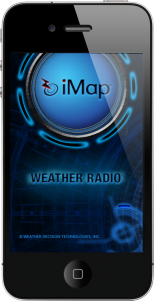Smartphone – Key to Weather Safety
by Mike Eilts, on Aug 8, 2011 1:06:43 PM
Driving in a car in a place that you are not familiar with can be a harrowing experience at times, especially if there is severe weather in the area. If you do not know which county you are in or what the local towns are, it is very hard to decipher whether a severe weather or tornado warning you hear over the radio is for where you are at or where you are driving to.
This happened to me early last week when I was driving my family from Minneapolis-St. Paul (MSP) to Northern Minnesota. But with today’s smartphone technology and WDT’s iMapWeather Radio app, I was warned in plenty of time to take action and steer clear of a severe thunderstorm that produced damaging winds over a wide swath of the suburbs of MSP. It is not my intent to market our company’s SmartPhone app in this blog, but it is a good case study to show how iMapWeather Radio and the latest smartphone capabilities really are life savers.
Here is the scenario. We were driving in the NW MSP suburbs in light rain showers when both my iPhone and iPad beeped and talked to me and told me that my current location was in a severe thunderstorm warning. I opened the iMapWeather Radio app and listened to the alert, then looked at the interactive map to determine where I was in relation to the storm and the warning. This is all made possible by iPhone providing its GPS location to apps and WDT’s patent-pending iMap Weather Radio app that gets those GPS locations and compares them to all NWS weather watches and warnings. If your iPhone is within the polygon of a watch or warning, and you are registered within the app to receive those type of watches or warnings, then an alert is sent to your iPhone.
So what did I do? I chose to drive perpendicular to the storm and not stop for lunch like we had planned. We did get into the edge of the storm, but only were in heavy rain and maybe 30 mph winds for less than 5 minutes.
This scenario shows how communicating severe weather warnings to mobile devices is one key way to communicate to the public. If I had heard the warning on the radio, I would not know which county I was in or what the local town names were. I did not have access to any other communication media, thus, a mobile device was the only way I could have received this warning. Additionally, being able to view the warning and radar echoes on an interactive map gave me situational awareness that was key in making a decision on how to proceed to ensure that my family and I were safe.
Smartphones are great tools for many reasons, but when it comes to weather safety they are a key component in communicating warnings, especially to people that are not at home.








